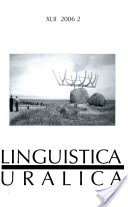Sources of Variability in the Duration of Stressed and Unstressed Syllable Nuclei in Erzya: Inter-Idiolect Data of Spontaneous Speech
Sources of Variability in the Duration of Stressed and Unstressed Syllable Nuclei in Erzya: Inter-Idiolect Data of Spontaneous Speech
Author(s): Niina AasmäeSubject(s): Language and Literature Studies
Published by: Eesti Teaduste Akadeemia Kirjastus
Keywords: Erzya; stress; duration; idiolect
Summary/Abstract: Analysis reported in this paper aimed at eliciting the effects of stress, vowel segment duration, openness/closedness of the syllable and number of syllables constituting the word upon the temporal relationship between the nuclei of adjoining stressed and unstressed syllables. Observations were made on spontaneously produced one-word utterances. Main spoken varieties of Erzya were represented in the materials by a group of idiolects characterised by the use of full vowels and three groups of idiolects exhibiting different types and degrees of vowel reduction. The results confirm the validity of indications obtained previously on the effects of word structure upon vowel duration in controlled speech. Analyses focused on the occurrences of comparable sets of vowels across the idiolect groups. The overall results revealed idiolect-specific sources of vowel duration variability. In the idiolects lacking reduction, stress and vowel duration were found to be independent. Vowels in the adjoining stressed and unstressed syllables tended to have equal duration. In the idiolects having reduction, the duration of the syllable nuclei showed dependence on stress. Stressed syllable nuclei were consistently longer than unstressed counterparts. The effect of the openness/closedness of the syllable was not explicitly manifested either in the reading or spontaneous speech data. Vowel duration variations in words with open/open and open/closed syllables were found to be statistically significant in some of the idiolects with reduction. Trisyllabic words compared to disyllabic ones in both types of idiolects had shorter syllable nuclei but higher duration ratios within the duple foot. Differences in the values of duration between stressed and unstressed syllable nuclei were not significant in the idiolects lacking reduction. The tendency towards equal duration of the vowels observed in disyllabic words persisted in trisyllabic words, as well. In the idiolects with reduction, statistically significant differences were found between vowel durations in the stressed and unstressed syllables both in di- and trisyllabic words, as well as between the duration ratios for the duple foot of trisyllabic and disyllabic words. Data obtained in the study provide evidence of differences in the rhythmic patterning of the two idiolect types.
Journal: Linguistica Uralica
- Issue Year: XLII/2006
- Issue No: 2
- Page Range: 81-93
- Page Count: 13
- Language: English

